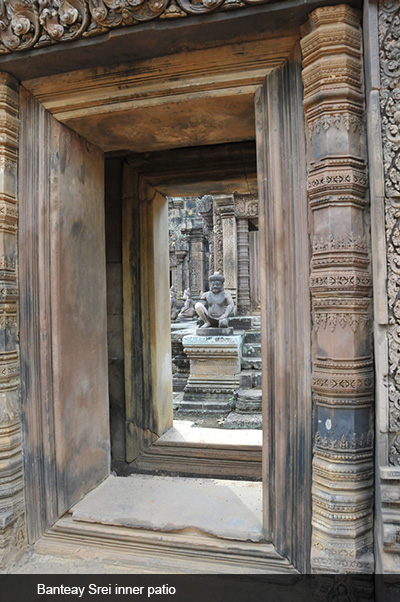
There are places in the world that call out to a person, even from a very young age. Angkor Wat in Cambodia was one of them for me. It’s hard for me to understand why. Yes, it is an ancient ruin of monumental proportions and exquisite art. And there is that mystery that lives in all such sites. But other ruins in other places—Tikal in Guatemala, Palenque in Mexico—embody cultures much more attuned to my sense of personal legacy. Neither Buddhism nor Hinduism, the two religions reflected at Angkor, ever did more than pique my curiosity. But then, no religion does. Still, whenever I saw a photograph of northern Cambodia, especially those in which the ruins featured, I felt an urgent pull.

Cambodia itself has long had a place in my consciousness. During the 1970s, when much of Southeast Asia was engulfed in war, my sense of guilt at what was being perpetrated in Vietnam, especially as a US American, extended as well to the other countries on the peninsula. All of Southeast Asia was in the news. We knew that much of what was happening there could be traced to our government policy and covert action.
In Cuba I met a Laotian student, my son’s comrade at the university, and marveled at his equanimity so far from home. He was studying engineering but, along with several other Laotian students in the country at the time, was also charged with creating the first Laotian/Spanish dictionary. Extreme poverty meant he wouldn’t be going home until he had completed his degree: five long years. When he wrote to his parents, he had to send his letters to the Communist Party secretary of his province who then made the long trip to visit his home. He was the only person within miles who knew how to read or write. That student’s courage broke my heart.
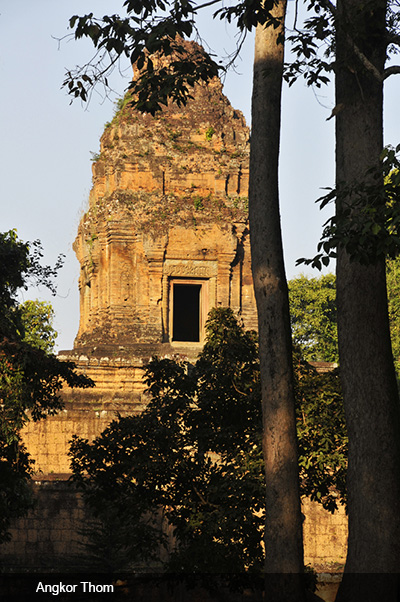
North Vietnamese diplomats, and representatives of the Pathet Lao (the revolutionary movement then struggling to gain control of Laos) always impressed me with their down to earth transparency and gentle demeanor. Several Vietnamese became good friends. Not so with the Cambodians with whom we had occasional contact. Representatives of the Khmer Rouge, at that time the movement we believed represented Cambodia’s revolutionary vanguard, struck me as deceitful and cold. They said the right things, but there was a rigid undertone I didn’t know how to read at the time. This was particularly true when I visited Vietnam in 1974 and paid a call at the offices of both the Pathet Lao and Khmer Rouge. The former seemed like brothers. The latter frightened me. Still, when Johnson bombed Cambodia, I believed he was bombing an authentic revolutionary struggle. The vast number of civilian deaths alone was enough to chill my blood.

When news of Cambodia’s Killing Fields began to appear in the Western press, I at first went along with the socialist bloc’s insistence that this was just another lie told to discredit the international Communist movement. It wouldn’t have been the first. But this time it was not a lie. Pol Pot and other Khmer Rouge leaders, calling themselves Communists, were committing genocide on a scale rarely seen before, and never since. As the truth emerged, it shifted all my parameters.
I think for many in my generation the Killing Fields were our Stalin Trials: the event that made us forever wary of automatically trusting those whose ideology we embraced, the event that made me question everything. Members of the Khmer Rouge leadership who were still alive were only brought to trial many years later. Recently the last of them died.
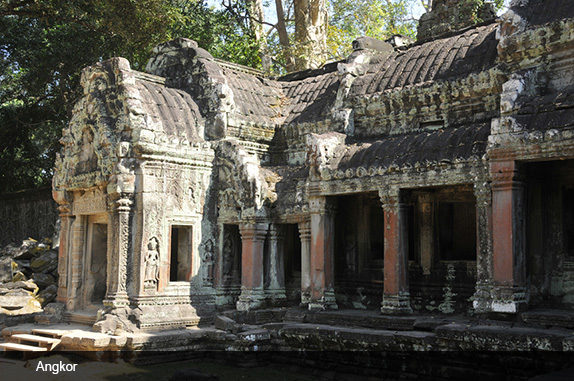
The Killing Fields demonstrated that words which I had been taught to believe meant the same thing everywhere—Communist, Socialist, Capitalist, today even Democrat and Republican—cannot be taken at face value. Communists in China, Vietnam, the Soviet Union, Cuba, or Czechoslovakia all had different ideas about how they wanted to create a new society, influenced of course by those nations’ vastly different histories and cultures. A Communist in one situation may not hold the same values as one in another, just as we have members of our own political parties who defend very different principles, or none at all.
In Cambodia something had gone horribly, criminally, wrong. Using a language recognized by revolutionaries everywhere, a group of murderous thugs were slaughtering almost half their country’s population. Children were thrown against trees until their skulls split open. Those who wore glasses or bore other signs of intellectualism were the first victims. Individuality was sacrificed to a brutally imposed collectivism. Those who didn’t starve to death were clubbed or shot. Two million bodies now lie beneath the earth. Each time it rains at the memorial near Phnom Pen, small shards of bone and teeth surface.
In a humanly lesser, though equally significant act, Pol Pot’s people used Angkor Wat’s irreplaceable monuments for target practice. Shooting at the carved stone was not simply an example of bully warfare gone mad. It was an attempt to destroy powerful cultural icons that formed an important part of the country’s collective memory.
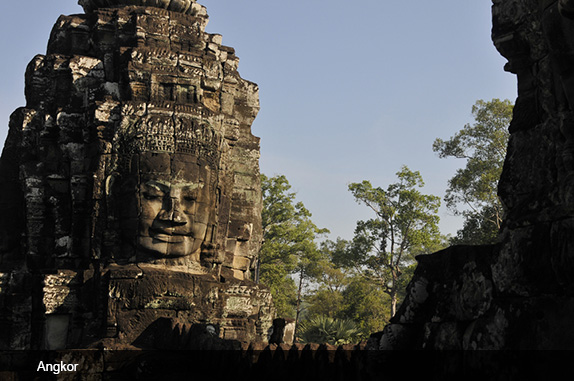
It was the Vietnamese, exhausted from their own heroic victory against US imperialism, who finally rescued what was left of the decimated Cambodian people. They discovered what was happening and, despite their allegiance to much more powerful China (Cambodia’s main ally at the time), decided they had to put a stop to it. They invaded and routed the Khmer Rouge, liberating the Killing Fields’ survivors much as World War II allies, thirty years before, liberated those who survived Auschwitz and Bergen-Belsen.
I imagined that the Cambodians must be grateful to the Vietnamese, just as European Jews held a debt of gratitude to the United States, Soviet Union, England and France. They do to a great extent. But when I visited Cambodia I learned that Vietnam, like so many other conquering nations, took its quota of gain. I was astonished, when I finally traveled to Angkor Wat, to discover that the ruins are a Vietnamese concession. Two million people visit the sites each year. When I was there, the day ticket cost $20 US. All that money goes to the Vietnamese concessionaire, not to impoverished Cambodia that surely deserves to profit from its heritage.
Cambodia is not only an impoverished nation. It is one that has suffered such collective stress that PTSD can be considered pandemic. Less than two generations since the Khmer Rouge terrorized an entire population, survivors and those born since, who carry the genocide in their genes, confront their recent past with the help of their Buddhist faith and practice.
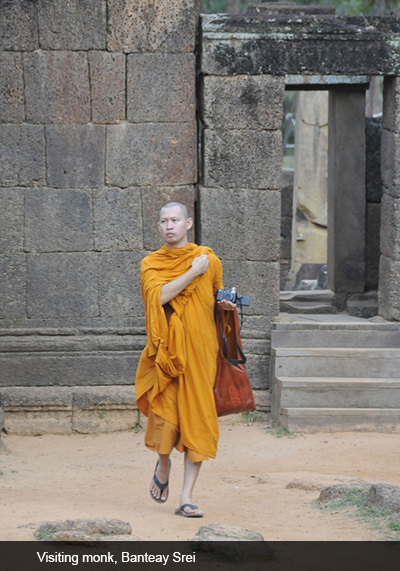
No family is immune to what happened. Memory is ever present, and memorials deeply shocking but dignified. Visiting the Killing Fields just outside Phnom Pen, in the company of a woman who had survived them from the age of 5 to liberation when she was 10, was an experience that will always be with me.
But I had come to Cambodia to see Angkor Wat. We took a bus through beautiful countryside north to Siem Reap.
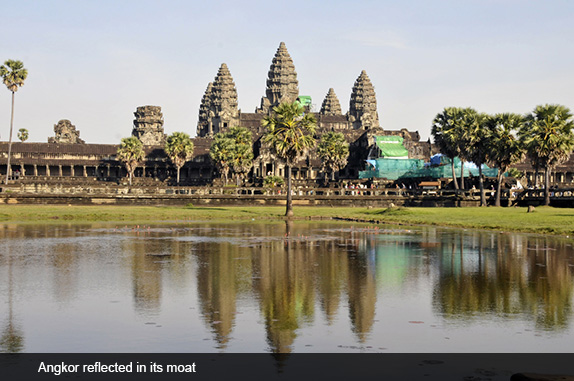
The ghosts of poets accompanied me. I remembered the Turkish poet Nazim Hikmet’s fascination with the place, Charles Olsen’s mention of it in The Kingfishers, and Allen Ginsberg’s pivotal poem, in which he asks the deities or perhaps just the ancient stones the poignant question: “Can I be queer?” I myself had no doubt I would write about Angkor Wat, though I couldn’t then have known the direction my own poem would take (Where Do We Go from Here? became a long poem against “isms” rather than a praise song to the ruin; and more than the densely-visited sites of Angkor Wat and Angkor Tom, the tiny outlier site of Banteay Srie stole my heart.)
Life around huge Tonle Sap lake has been traced back to Neolithic times, although the great temples were built much more recently. Angkor’s era of greatest glory was from 1080 to 1175, concurrent with our own Ancestral Puebloan communities on the other side of the world. The Khmer people have always known about Angkor, but it was “discovered” for European eyes by the French at mid-19th century, and it was a series of French archeologists who led the major research studies and restorations. In 1923, the great French intellectual and DeGaulle’s Minister of Culture André Malraux actually stole four apsaras from Banteay Srei, but was forced to return them.
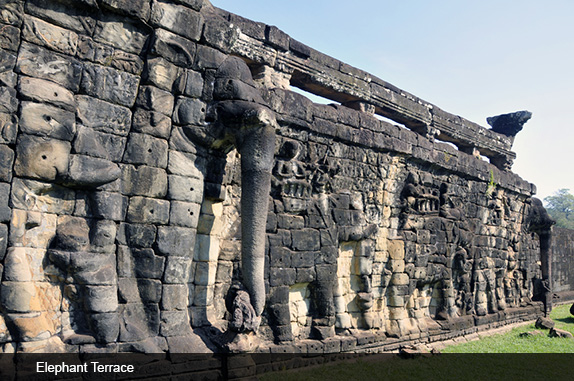
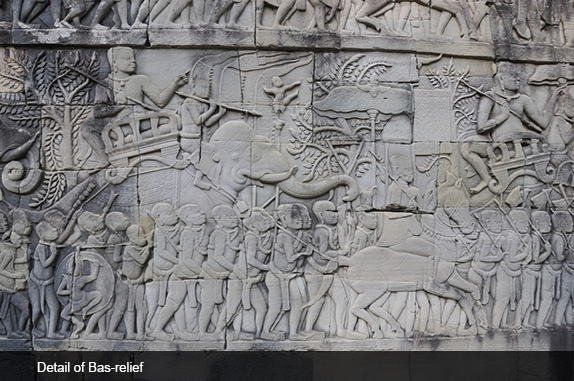
One must remember that most of the sites one visits today were not meeting places for the faithful but shrines to different gods—400 alone at Preah Khan. Communities or cities surrounded these sites. In places one can see the faint grids of what once were streets. But these living spaces have mostly been eaten by jungle. The great conglomeration of temples may create an effect of total chaos to eyes unaccustomed to temples crowding temples. Most of us aren’t used to the detailed busyness of modern Hindu art, much less the ruins of what remains from bygone eras.
Although Angkor Wat is the shining star of Cambodia’s tourist attractions, it is only one of hundreds of such sites throughout the northern part of the country. Poverty has always been present. At one point on our journey north, we crossed a beautiful old laterite bridge. We stopped to admire its graceful proportions, and learned that at least 13 similar bridges have been discovered over the years, but that this is the only one not dismantled in order to use its bricks for other building projects.
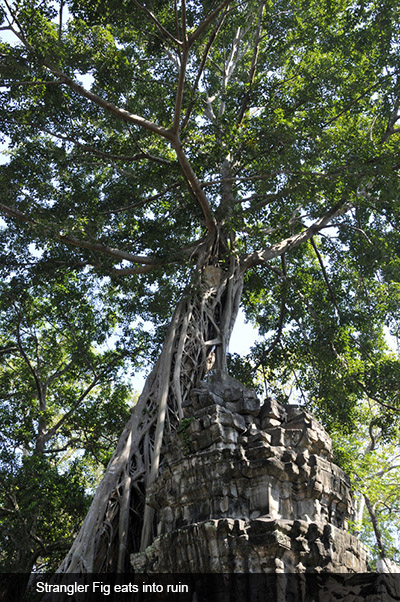
Baked brick, sandstone, and laterite are the three building materials used throughout the temples. The bricks were of different sizes, and held together by a vegetable compound rather than mortar. Many of the brick facades were covered with stucco and painted, though few of the paintings survive. A wet climate hasn’t favored their preservation. Sandstone from the nearby Kulen mountains was also a popular building material. Laterite is an iron-rich clay that is malleable when extracted from the earth but hardens when exposed to the air. Wood was occasionally used in roofs and lintels.
Angkor itself dates to the 9th century AD, when King Jayavarman II exerted his enormous influence through the land. Mahayana Buddhism came from India along with its gods and goddesses. Then waves of Hinduism immigrated from the same direction: the four-armed Vishnu restoring harmony to the world, Shiva bringing destruction and rebirth, and others. These imported deities allowed for coexistence with local indigenous gods. Easy syncretism was, perhaps, what permitted the survival of this mix of traditions.
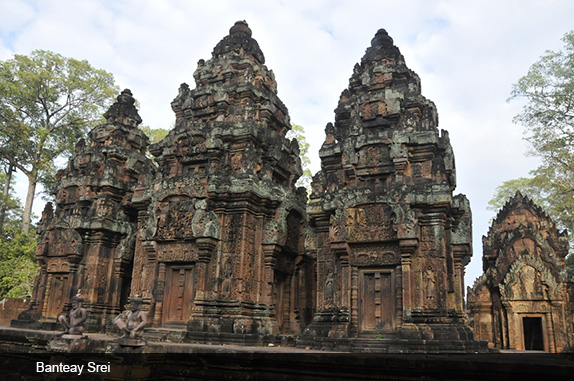
Almost all Cambodian archeological sites were originally compounds built by kings. Their walls can be read as a history of battles, conquests, warriors and slaves. Angkor is vast. Its central quadrangle faces a broad moat. Orange-robed monks strolling among the hundreds of other visitors there on any given day reminded me of a time when monastery life was even more important than it is now.
The moat contained too many Styrofoam cups. It was hot and humid and I constantly found myself being nudged and pummeled through the narrower passages. Parts of the main temple were under repair, and scaffolding was swathed in green plastic tarps. I noticed how people reached and crouched, trying to position their cameras so as not to let that green plastic into the pictures they were taking. I rested awhile, sitting on a stone wall, gibbons playing at my feet. One large male approached and sat beside me. Suddenly he began to masturbate. He seemed to be grinning.
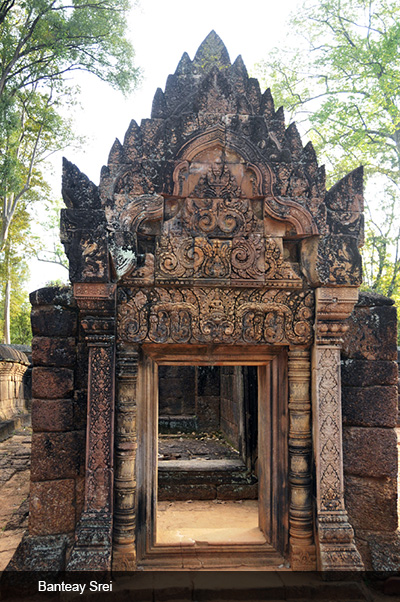
I made my way toward the great buildings again, determined to see as much as I could of this place I had dreamed of for so long. Areas of Angkor Wat and Angkor Thom held me in with their magic. Most of these were far from the central compound. I loved the Elephant Terrace, the stone trunks of the immense animals protruding from the deep bas-relief of the supporting platform. I also became absorbed in The Leper King Terrace, covered with evocative carvings. I spent time in the comforting shade of nearby Preah Palilay, where the intertwining roots of giant Strangler Fig trees embrace and disrupt the ancient buildings at one and the same time.
In contrast with other ancient sites, built with the fervor of particular religious or philosophical systems, an interesting characteristic of these Cambodian ruins is that they were built to glorify Buddhism, taken over by Hindus, and then returned to Buddhist domination, depending on who was in control in a particular era. This back and forth provoked changes in the features of statuary: gods and kings changed masks and silk sashes according to the period.
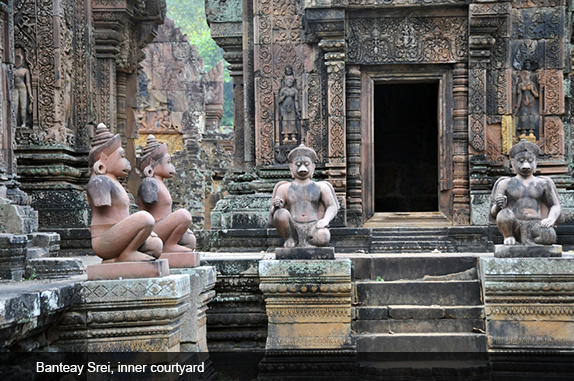
I’m not going to go into great detail about the Khmer culture that produced these amazing sites. Many books exist on the subject. I do want to talk about the vague disappointment I experienced—one of those set-ups in which you expected so much you can’t help but come away feeling unfulfilled—and then the discovery that made it all right.
It had been a long day at Angkor Wat, Angkor Tom, and adjoining ruins. When I could somehow escape the crowds, I was able to absorb some of the wonder they exude. Sheer scale is transformative because it envelops the visitor. A silent structure, not invaded for the moment by anyone else, proved a relief. Photographing the marvelous bass-relief throughout many of the temples was thrilling.
But something gnawed at me. Finally I realized what it was: all the triumphant scenes of battle were so male-centered. Sculpted women’s bodies were highly stylized; they seemed to portray the female form more for male pleasure than as a reflection of female life. The famous apsaras were celestial beings, but their earthly representatives dance in Siem Reap’s dinner clubs and tourist haunts. The essence of Shiva was often represented by linga, the shaft of stone so obviously depicting a phallus.
Finally, toward the end of the afternoon, we traveled 20 kilometers north to Banteay Srei. That was where everything fell into place for me. The site is a very small compound, built by King Rajendravarman’s counselor or teacher, Yajãvaraha: the only complex not built by a king and to glorify his rein. Some say it was so small because the pink sandstone was from a quarry with a limited amount of stone. But Banteay Srei isn’t just small in size. It is intimate in concept, rich in artistic detail but not meant to overwhelm.
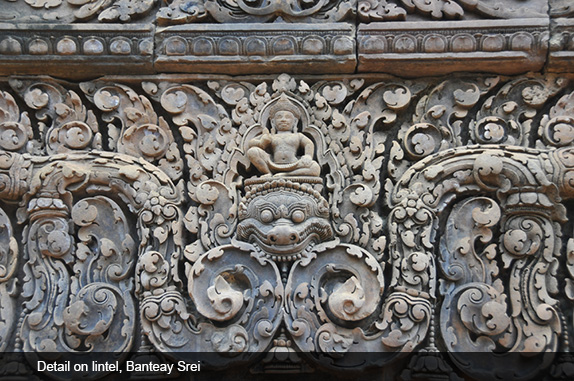
Built along the upper Siem Reap River, its name can be translated as Citadel of Women. And women are everywhere on its facades. That the place is woman-centered isn’t exactly what captivated me, but rather the fact that it is not a monument to conquest. There is no violence here. The bas-relief and statuary are among the finest in all Khmer art—in invention, richness, and execution. The pink sandstone is extremely hard and has weathered very little, leaving the depth of three-dimensional carving on one-dimensional surfaces. The faint gray-green of lichen adds interest.
The small dimensions of Banteay Srei bring one in contact with the art in a way that is impossible at the larger sites. Rooflines, arches and lintels that remain far above the visitor’s head at Angkor are at eye level here. A patio of curious figures, half-monkey half-human, seem comical and strangely familiar. The sun was beginning to set, casting a glow over the complex. Above the elaborately carved arches and through surprising doorways and windows, the lacey green of the forest contrasted with the pink rock.
I walked around Banteay Srei, exploring every corner of light and shadow, broken walls and perfect statuary. Few of the references were familiar. But surrounded by art from a culture different from anything my own memory holds, I felt completely at home. I was able to tap into that unifying unconscious that links us all.
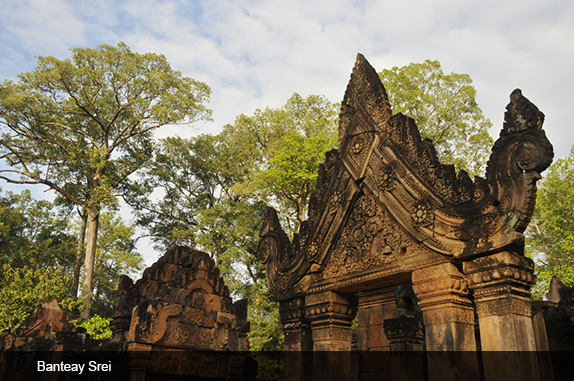

September 13, 2013